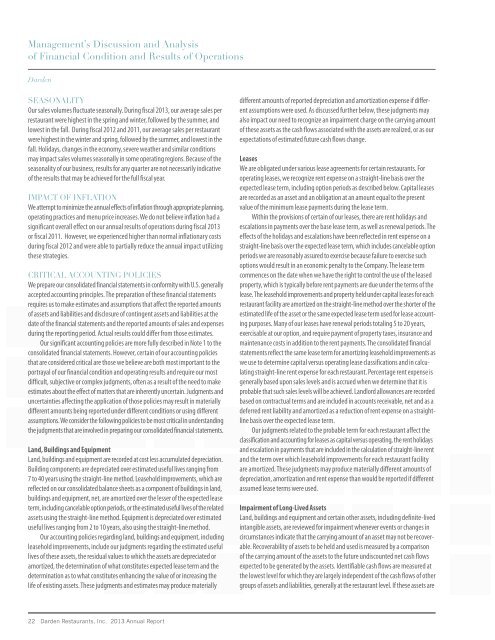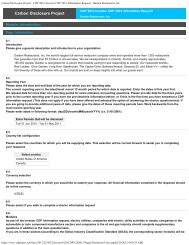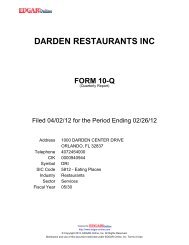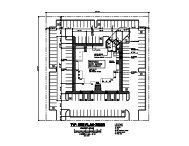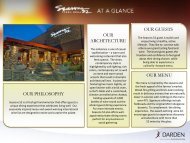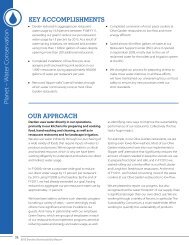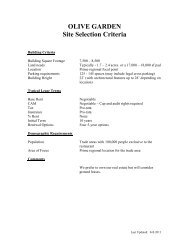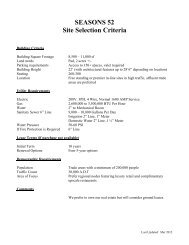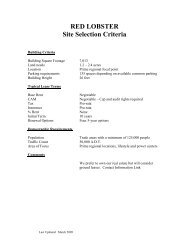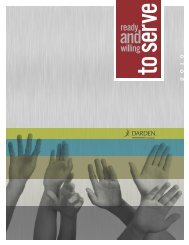Management’s Discussion and Analysisof Financial Condition and Results of Operations<strong>Darden</strong>SEASONALITYOur sales volumes fluctuate seasonally. During fiscal <strong>2013</strong>, our average sales perrestaurant were highest in the spring and winter, followed by the summer, andlowest in the fall. During fiscal 2012 and 2011, our average sales per restaurantwere highest in the winter and spring, followed by the summer, and lowest in thefall. Holidays, changes in the economy, severe weather and similar conditionsmay impact sales volumes seasonally in some operating regions. Because of theseasonality of our business, results for any quarter are not necessarily indicativeof the results that may be achieved for the full fiscal year.IMPACT OF INFLATIONWe attempt to minimize the annual effects of inflation through appropriate planning,operating practices and menu price increases. We do not believe inflation had asignificant overall effect on our annual results of operations during fiscal <strong>2013</strong>or fiscal 2011. However, we experienced higher than normal inflationary costsduring fiscal 2012 and were able to partially reduce the annual impact utilizingthese strategies.CRITICAL ACCOUNTING POLICIESWe prepare our consolidated financial statements in conformity with U.S. generallyaccepted accounting principles. The preparation of these financial statementsrequires us to make estimates and assumptions that affect the reported amountsof assets and liabilities and disclosure of contingent assets and liabilities at thedate of the financial statements and the reported amounts of sales and expensesduring the reporting period. Actual results could differ from those estimates.Our significant accounting policies are more fully described in Note 1 to theconsolidated financial statements. However, certain of our accounting policiesthat are considered critical are those we believe are both most important to theportrayal of our financial condition and operating results and require our mostdifficult, subjective or complex judgments, often as a result of the need to makeestimates about the effect of matters that are inherently uncertain. Judgments anduncertainties affecting the application of those policies may result in materiallydifferent amounts being reported under different conditions or using differentassumptions. We consider the following policies to be most critical in understandingthe judgments that are involved in preparing our consolidated financial statements.Land, Buildings and EquipmentLand, buildings and equipment are recorded at cost less accumulated depreciation.Building components are depreciated over estimated useful lives ranging from7 to 40 years using the straight-line method. Leasehold improvements, which arereflected on our consolidated balance sheets as a component of buildings in land,buildings and equipment, net, are amortized over the lesser of the expected leaseterm, including cancelable option periods, or the estimated useful lives of the relatedassets using the straight-line method. Equipment is depreciated over estimateduseful lives ranging from 2 to 10 years, also using the straight-line method.Our accounting policies regarding land, buildings and equipment, includingleasehold improvements, include our judgments regarding the estimated usefullives of these assets, the residual values to which the assets are depreciated oramortized, the determination of what constitutes expected lease term and thedetermination as to what constitutes enhancing the value of or increasing thelife of existing assets. These judgments and estimates may produce materiallydifferent amounts of reported depreciation and amortization expense if differentassumptions were used. As discussed further below, these judgments mayalso impact our need to recognize an impairment charge on the carrying amountof these assets as the cash flows associated with the assets are realized, or as ourexpectations of estimated future cash flows change.LeasesWe are obligated under various lease agreements for certain restaurants. Foroperating leases, we recognize rent expense on a straight-line basis over theexpected lease term, including option periods as described below. Capital leasesare recorded as an asset and an obligation at an amount equal to the presentvalue of the minimum lease payments during the lease term.Within the provisions of certain of our leases, there are rent holidays andescalations in payments over the base lease term, as well as renewal periods. Theeffects of the holidays and escalations have been reflected in rent expense on astraight-line basis over the expected lease term, which includes cancelable optionperiods we are reasonably assured to exercise because failure to exercise suchoptions would result in an economic penalty to the Company. The lease termcommences on the date when we have the right to control the use of the leasedproperty, which is typically before rent payments are due under the terms of thelease. The leasehold improvements and property held under capital leases for eachrestaurant facility are amortized on the straight-line method over the shorter of theestimated life of the asset or the same expected lease term used for lease accountingpurposes. Many of our leases have renewal periods totaling 5 to 20 years,exercisable at our option, and require payment of property taxes, insurance andmaintenance costs in addition to the rent payments. The consolidated financialstatements reflect the same lease term for amortizing leasehold improvements aswe use to determine capital versus operating lease classifications and in calculatingstraight-line rent expense for each restaurant. Percentage rent expense isgenerally based upon sales levels and is accrued when we determine that it isprobable that such sales levels will be achieved. Landlord allowances are recordedbased on contractual terms and are included in accounts receivable, net and as adeferred rent liability and amortized as a reduction of rent expense on a straightlinebasis over the expected lease term.Our judgments related to the probable term for each restaurant affect theclassification and accounting for leases as capital versus operating, the rent holidaysand escalation in payments that are included in the calculation of straight-line rentand the term over which leasehold improvements for each restaurant facilityare amortized. These judgments may produce materially different amounts ofdepreciation, amortization and rent expense than would be reported if differentassumed lease terms were used.Impairment of Long-Lived AssetsLand, buildings and equipment and certain other assets, including definite-livedintangible assets, are reviewed for impairment whenever events or changes incircumstances indicate that the carrying amount of an asset may not be recoverable.Recoverability of assets to be held and used is measured by a comparisonof the carrying amount of the assets to the future undiscounted net cash flowsexpected to be generated by the assets. Identifiable cash flows are measured atthe lowest level for which they are largely independent of the cash flows of othergroups of assets and liabilities, generally at the restaurant level. If these assets are22 <strong>Darden</strong> <strong>Restaurants</strong>, Inc. <strong>2013</strong> <strong>Annual</strong> <strong>Report</strong>
Management’s Discussion and Analysisof Financial Condition and Results of Operations<strong>Darden</strong>determined to be impaired, the amount of impairment recognized is measuredby the amount by which the carrying amount of the assets exceeds their fair value.Fair value is generally determined by appraisals or sales prices of comparable assets.Restaurant sites and certain other assets to be disposed of are reported at the lowerof their carrying amount or fair value, less estimated costs to sell. Restaurant sitesand certain other assets to be disposed of are included in assets held for sale withinprepaid expenses and other current assets in our consolidated balance sheets whencertain criteria are met. These criteria include the requirement that the likelihoodof disposing of these assets within one year is probable. For assets that meet theheld-for-sale criteria, we separately evaluate whether those assets also meet therequirements to be reported as discontinued operations. Principally, if we discontinuecash flows and no longer have any significant continuing involvement withrespect to the operations of the assets, we classify the assets and related resultsof operations as discontinued. We consider guest transfer (an increase in guestsat another location as a result of the closure of a location) as continuing cashflows and evaluate the significance of expected guest transfer when evaluatinga restaurant for discontinued operations reporting. To the extent we dispose ofenough assets where classification between continuing operations and discontinuedoperations would be material to our consolidated financial statements,we utilize the reporting provisions for discontinued operations. Assets whosedisposal is not probable within one year remain in land, buildings and equipmentuntil their disposal within one year is probable.We account for exit or disposal activities, including restaurant closures, inaccordance with Financial Accounting Standards Board (FASB) Accounting StandardsCodification (ASC) Topic 420, Exit or Disposal Cost Obligations. Such costs includethe cost of disposing of the assets as well as other facility-related expenses frompreviously closed restaurants. These costs are generally expensed as incurred.Additionally, at the date we cease using a property under an operating lease, werecord a liability for the net present value of any remaining lease obligations, netof estimated sublease income. Any subsequent adjustments to that liability as aresult of lease termination or changes in estimates of sublease income are recordedin the period incurred. Upon disposal of the assets, primarily land, associated witha closed restaurant, any gain or loss is recorded in the same caption within ourconsolidated statements of earnings as the original impairment.The judgments we make related to the expected useful lives of long-livedassets and our ability to realize undiscounted cash flows in excess of the carryingamounts of these assets are affected by factors such as the ongoing maintenanceand improvements of the assets, changes in economic conditions, changes in usageor operating performance, desirability of the restaurant sites and other factors,such as our ability to sell our assets held for sale. As we assess the ongoing expectedcash flows and carrying amounts of our long-lived assets, significant adversechanges in these factors could cause us to realize a material impairment loss. Duringfiscal <strong>2013</strong>, we recognized long-lived asset impairment charges of $0.8 million($0.5 million net of tax), primarily related to the write-down of assets held fordisposition based on updated valuations. During fiscal 2012, we recognizedlong-lived asset impairment charges of $0.5 million ($0.3 million net of tax),primarily related to the permanent closure of one Red Lobster restaurant, and thewrite-down of assets held for disposition based on updated valuations. Duringfiscal 2011 we recognized long-lived asset impairment charges of $4.7 million($2.9 million net of tax), primarily related to the permanent closure of two RedLobster restaurants, the write-down of another Red Lobster restaurant based onan evaluation of expected cash flows, and the write-down of assets held fordisposition based on updated valuations. These costs are included in selling,general and administrative expenses as a component of earnings from continuingoperations in the accompanying consolidated statements of earnings for fiscal<strong>2013</strong>, 2012 and 2011. Impairment charges were measured based on the amountby which the carrying amount of these assets exceeded their fair value.Valuation and Recoverability of Goodwill and TrademarksWe review our goodwill and trademarks for impairment annually, as of the firstday of our fiscal fourth quarter, or more frequently if indicators of impairment exist.Goodwill and trademarks are not subject to amortization and have been assignedto reporting units for purposes of impairment testing. The reporting units areour restaurant brands. At May 26, <strong>2013</strong> and May 27, 2012, we had goodwill of$908.3 million and $538.6 million, respectively. At May 26, <strong>2013</strong> and May 27, 2012,we had trademarks of $573.8 million and $464.9 million, respectively.A significant amount of judgment is involved in determining if an indicator ofimpairment has occurred. Such indicators may include, among others: a significantdecline in our expected future cash flows; a sustained, significant decline inour stock price and market capitalization; a significant adverse change in legalfactors or in the business climate; unanticipated competition; the testing forrecoverability of a significant asset group within a reporting unit; and slowergrowth rates. Any adverse change in these factors could have a significant impacton the recoverability of these assets and could have a material impact on ourconsolidated financial statements.The goodwill impairment test involves a two-step process. The first step is acomparison of each reporting unit’s fair value to its carrying value. We estimatefair value using the best information available, including market information anddiscounted cash flow projections (also referred to as the income approach). Theincome approach uses a reporting unit’s projection of estimated operating resultsand cash flows that is discounted using a weighted-average cost of capital thatreflects current market conditions. The projection uses management’s best estimatesof economic and market conditions over the projected period includinggrowth rates in sales, costs and number of units, estimates of future expectedchanges in operating margins and cash expenditures. Other significant estimatesand assumptions include terminal value growth rates, future estimates of capitalexpenditures and changes in future working capital requirements. We validate ourestimates of fair value under the income approach by comparing the values tofair value estimates using a market approach. A market approach estimates fairvalue by applying cash flow and sales multiples to the reporting unit’s operatingperformance. The multiples are derived from comparable publicly traded companieswith similar operating and investment characteristics of the reporting units.If the fair value of the reporting unit is higher than its carrying value, goodwillis deemed not to be impaired, and no further testing is required. If the carryingvalue of the reporting unit is higher than its fair value, there is an indication thatimpairment may exist and the second step must be performed to measure theamount of impairment loss. The amount of impairment is determined by comparingthe implied fair value of reporting unit goodwill to the carrying value ofthe goodwill in the same manner as if the reporting unit was being acquired in abusiness combination. Specifically, we would allocate the fair value to all of theassets and liabilities of the reporting unit, including any unrecognized intangibleassets, in a hypothetical analysis that would calculate the implied fair value ofgoodwill. If the implied fair value of goodwill is less than the recorded goodwill,we would record an impairment loss for the difference.<strong>Darden</strong> <strong>Restaurants</strong>, Inc. <strong>2013</strong> <strong>Annual</strong> <strong>Report</strong> 23


